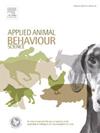探索群居断奶前乳牛的基线行为
IF 2.2
2区 农林科学
Q1 AGRICULTURE, DAIRY & ANIMAL SCIENCE
引用次数: 0
摘要
随着公众对农场动物福利的关注与日俱增,了解其福利现状至关重要。动物福利可以从它们的行为中推断出来,因为行为代表了内部和外部线索的结合。本研究的目的是量化在传统管理条件下饲养的群居断奶前乳牛的行为基线,并确定不同的内部因素(如年龄)和外部因素(如温度)对这一行为的影响。雌性奶牛犊牛(47 头)根据出生日期被分配到 3 个栏中的 1 个,在爱尔兰传统管理条件下饲养;在单个栏中饲养 3-4 天后,犊牛被转移到集体栏中,在集体栏中,犊牛可以自由取用水、精料和饲料(首先是大麦秸秆,然后是干草)。代乳品(6 升/天)通过自动喂奶器喂给;犊牛从第 42-84 天开始逐渐断奶。连续 8 周每周 24 小时的视频记录用于行为评分(每隔 10 分钟扫描取样一次)。行为包括姿势(躺或站)和活动(17 种行为)。每周两次对犊牛的临床健康状况进行评分,只有健康的犊牛才被用于分析(n=39)。行为比例采用广义线性混合模型进行分析。随着犊牛年龄的增长,躺卧时间比例减少(第 1 周 vs. 第 9 周;百分比平均值 ± 标准差;79.8 ± 4.04 vs. 72.1 ± 6.52 %;P=0.004),而反刍时间(2.0 ± 2.51 vs. 14.1 ± 8.72 %;P<0.001)、吃垫料(0.8 ± 1.16 vs. 6.1 ± 4.66 %;P<0.001)、吃草料(0.9 ± 1.20 vs. 1.8 ± 1.81 %;P=0.007)和吃精料(0.5 ± 1.15 vs. 2.2 ± 1.72 %;P=0.018)的时间随着年龄的增长而增加。在最低舍温为 <4°C 的日子里,犊牛躺卧的时间更长(75.9 ± 5.27 vs. 72.3 ± 5.78 %;P<0.001),吃精料的时间更短(0.8 ± 1.11 vs. 1.4 ± 1.49 %;P=0.035)、吃草料(0.8 ± 0.91 vs. 1.5 ± 1.57 %;P=0.005)、吃垫料(2.7 ± 2.87 vs. 4.0 ± 4.78 %;P=0.003)和行走(1.5 ± 1.20 vs. 2.0 ± 1.40 %;P=0.017)的时间较少,与年龄无关。这些发现为今后的犊牛行为研究提供了一个正常行为基线,并突出了当前传统犊牛饲养方法中可能需要改进的地方。本文章由计算机程序翻译,如有差异,请以英文原文为准。
Exploring baseline behaviour in group-housed, pre-weaned dairy calves
With increasing public concern for farm animal welfare, understanding their current welfare status is paramount. Animal welfare can be inferred from their behaviour, as behaviour represents the combination of internal and external cues. The aims of this study were to quantify a behavioural baseline for group-housed, pre-weaned dairy calves that were reared under conventional management conditions, and to determine how different internal (i.e. age) and external (i.e. temperature) factors affected this behaviour. Female dairy calves (n=47) were allocated to 1 of 3 pens based on birth date and reared under conventional Irish management conditions; after 3–4 d in individual pens, calves were moved into group pens where they had ad libitum access to water, concentrates, and forage (first barley straw, then hay). Milk replacer (6 L/d) was fed through an automatic milk feeder; calves were gradually weaned from day 42–84. A 24 h period/week of video recording was used for behaviour scoring for 8 consecutive weeks (scan sampling at 10-min intervals). Behaviours included posture (lying or standing) and activity (17 behaviours). Calves were scored for clinical health twice weekly and only healthy calves were used in the analysis (n=39). Behaviour proportions were analysed using generalised linear mixed models. Proportion of time spent lying decreased as calves aged (week 1 vs. 9; percentage mean ± standard deviation; 79.8 ± 4.04 vs. 72.1 ± 6.52 %; P=0.004), while time spent ruminating (2.0 ± 2.51 vs. 14.1 ± 8.72 %; P<0.001), eating bedding (0.8 ± 1.16 vs. 6.1 ± 4.66 %; P<0.001), eating forage (0.9 ± 1.20 vs. 1.8 ± 1.81 %; P=0.007), and eating concentrates (0.5 ± 1.15 vs. 2.2 ± 1.72 %; P=0.018) increased with age. On days when the minimum shed temperature was <4°C compared to >6°C, calves spent more time lying (75.9 ± 5.27 vs. 72.3 ± 5.78 %; P<0.001) and less time eating concentrates (0.8 ± 1.11 vs. 1.4 ± 1.49 %; P=0.035), eating forage (0.8 ± 0.91 vs. 1.5 ± 1.57 %; P=0.005), eating bedding (2.7 ± 2.87 vs. 4.0 ± 4.78 %; P=0.003), and walking (1.5 ± 1.20 vs. 2.0 ± 1.40 %; P=0.017), independent of age. These findings provide a normal behaviour baseline for future calf behaviour studies and highlight potential areas of improvement in current, conventional calf rearing practices.
求助全文
通过发布文献求助,成功后即可免费获取论文全文。
去求助
来源期刊

Applied Animal Behaviour Science
农林科学-行为科学
CiteScore
4.40
自引率
21.70%
发文量
191
审稿时长
18.1 weeks
期刊介绍:
This journal publishes relevant information on the behaviour of domesticated and utilized animals.
Topics covered include:
-Behaviour of farm, zoo and laboratory animals in relation to animal management and welfare
-Behaviour of companion animals in relation to behavioural problems, for example, in relation to the training of dogs for different purposes, in relation to behavioural problems
-Studies of the behaviour of wild animals when these studies are relevant from an applied perspective, for example in relation to wildlife management, pest management or nature conservation
-Methodological studies within relevant fields
The principal subjects are farm, companion and laboratory animals, including, of course, poultry. The journal also deals with the following animal subjects:
-Those involved in any farming system, e.g. deer, rabbits and fur-bearing animals
-Those in ANY form of confinement, e.g. zoos, safari parks and other forms of display
-Feral animals, and any animal species which impinge on farming operations, e.g. as causes of loss or damage
-Species used for hunting, recreation etc. may also be considered as acceptable subjects in some instances
-Laboratory animals, if the material relates to their behavioural requirements
 求助内容:
求助内容: 应助结果提醒方式:
应助结果提醒方式:


